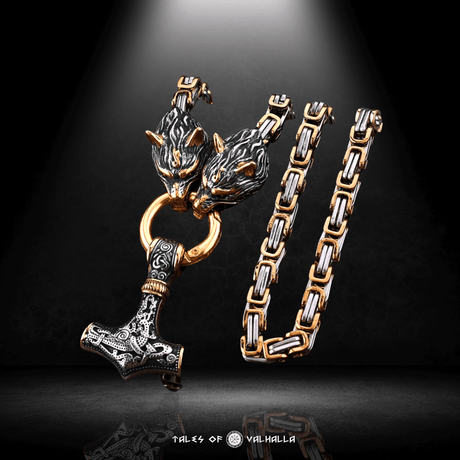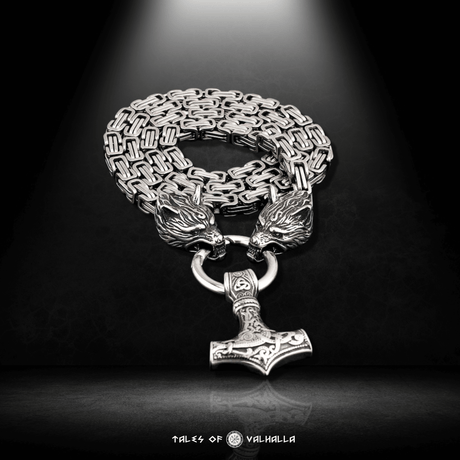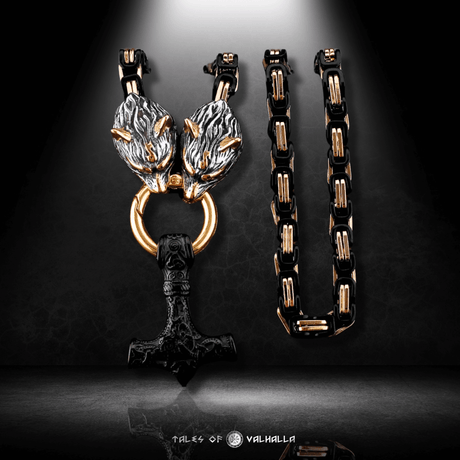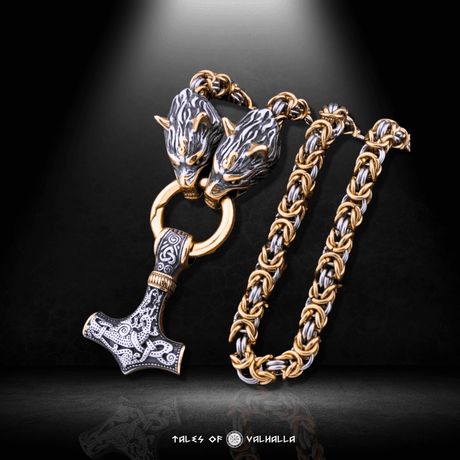Having been at the center of daily life and warfare of the Norse, the craftsmanship of the Vikings somehow bridged time to be a source of admiration and fascination in this existing world. From mighty axes and swords that terrified foes on the battlefield, to incredibly well-engineered jewelry worn for faith, status, and heritage, the craftsmanship of the Vikings speaks to the skill, artistry, and cultural depth of these legendary people.
Today, Viking craftsmanship is an inspiration to modern-day artisans who continue to create and interpret the magnificent weapons and adornments that once defined the Viking Age. We shall discuss herein the traditional process behind the creation of Viking axes, swords, and jewelry and how those processes have continued into the modern age. We will also outline how tremendous craftsmanship and profound love for Viking culture have made Tales of Valhalla a famous brand, respected by both history enthusiasts and fans of the culture of the Vikings.
Viking Craftsmanship: Art and Warfare in One
The crafting ability of the Viking was important in the Viking society of Norse not only for the practical battle, agriculture, and livelihood purposes but also held cultural and spiritual values. All the arms and tools built by the Viking smiths were part of their identity, much like their ships and longhouses. Every piece they made had its symbolic meaning, be it the runes on their ornaments or the designs on their battle axes.
Skill and Rank: A Symbol of Craftsmanship
Craftsmanship in the Viking Age related not only to mere functionality but showed wealth, status, and belief. Great warriors and chieftains used swords and axes with beautiful decoration, while the elite wore silver and gold jewelry. Most of these items descended over generations, carrying stories and legacies of their masters.
These too were handiwork that required skill and craftsmanship of high order, placing the Viking craftsmen in a position of esteem in society.
The Forging of Viking Axes
Every Blow Carries Power Among all the instruments and weapons that the Vikings employed, the axe is an icon when one thinks about it. Be that as it may, axes were quite intimidating among their enemies in battles. Enemies who had to go through the Vikings greatly feared the axe because it was brutally effective and expertly used.

The Forging of Viking Axes
Step-by-Step Process of Making Viking Axes
-
Gathering the Materials: The process begins with sourcing raw materials. Vikings primarily used iron, occasionally adding steel for extra durability. The iron ore would be mined and extracted by heating and hammering the material to separate the metal.
-
Heating the Iron: Once extracted, the iron is heated in a forge—a furnace capable of reaching extreme temperatures. This softens the iron, making it easier to shape and work with.
-
Shaping with Hammering: After heating, the blacksmith would repeatedly hammer the hot iron on an anvil, gradually shaping it into the desired form. This process of heating and hammering would continue until the metal took on the general shape of the axe.
-
Forming the Tang: The tang, the part of the axe that extends into the handle, is carefully crafted from the blade’s metal. The blacksmith precisely shapes it to fit securely into the handle, ensuring balance and control.
-
Crafting the Guard and Pommel: For axes with additional components like guards or pommels, these are crafted separately, often from iron, and are designed to provide protection and weight balance for the wielder.
-
Adding the Fuller: A groove, known as the fuller, may be added to reduce the blade’s weight without sacrificing strength. By removing excess material from the center, the axe becomes lighter and more efficient in combat.
-
Hardening the Blade: Once the basic shape is achieved, the blade undergoes hardening. This involves heating it again to a precise temperature before rapidly cooling it in water or oil. This step increases the blade’s toughness and durability.
-
Finishing Touches: The final steps include polishing and sharpening the blade. Some axes are further decorated with intricate designs or precious metal inlays, elevating them from tools of war to works of art.
Cultural Significance of Viking Axes
Meanwhile, the Viking axe had a meaning not only in battles but also was a deeply symbolic thing. The axe of the warrior expressed his strength, honor, and god's benevolence laid upon him. Many heroes in sagas are featured with huge axes; usually, those were given by gods or passed down through generations. Owning a well-crafted axe was an assertion of status and respect in Norse society.
Viking Swords: Prestige to the greatest degree.
Axes were the most common weapons to be wielded by the Vikings, and this is in comparison with swords, which were highly rare and essentially very valuable. The Viking sword symbolizes very high status, meant for only chieftains, rich warriors, and kings. Making a Viking sword was an intricate process that entailed immense skill; hence, these weapons rank among the most admired artifacts from the Viking Age.

Step-by-Step Process of Crafting Viking Swords
-
Gathering the Materials: The first step in crafting a Viking sword involved sourcing the raw materials. Vikings primarily used iron, occasionally combining it with steel to increase the blade's strength. The iron ore was mined and refined through a process of heating and hammering to extract the metal.
- Heating the Iron: The extracted iron was heated in a forge, a specialized furnace capable of reaching extremely high temperatures. This process made the iron more malleable, allowing it to be shaped more easily.
- Forging the Blade: Once the iron was sufficiently hot, the blacksmith would repeatedly hammer it on an anvil to shape it into the form of a sword. This hammering and shaping process continued until the general sword shape emerged, with the metal being heated and worked multiple times.
- Creating the Tang: The tang is the part of the sword that extends into the hilt. The blacksmith would carefully shape the tang to fit seamlessly into the handle, ensuring the sword’s balance and structural integrity.
- Shaping the Guard and Pommel: The guard, which protects the wielder's hand, and the pommel, the counterweight at the end of the hilt, were forged separately. These components were typically made from iron and shaped to fit the sword precisely.
- Adding the Fuller: A fuller, or groove, was added along the blade to improve its cutting ability. This channel lightened the blade while maintaining its strength, ensuring it was not too heavy but still durable in battle.
- Hardening the Blade: After the sword’s shape was finalized, the blade underwent a hardening process. This involved heating it once more and then rapidly quenching it in water or oil. This technique gave the blade its toughness and durability.
- Finishing Touches: The final step in crafting a Viking sword was polishing and sharpening. Some swords were adorned with intricate designs or inlaid with precious metals, turning them into both functional weapons and works of art.
Swords as Family Heirlooms and Symbols of Power
Many swords in the Viking culture were passed down through generations, thus becoming treasured family heirlooms. Here, the craftsmanship of such weapons represented the skill and status not only of the maker but also of the owner. A good sword would mean more than just a useful weapon in a fight; it was a symbol of power, lineage, and signals of divine favor. Some swords of the Viking age had magical connotations, with protective powers and strength granted to the owner during the time of war.
Viking Jewelry: Delicacy in the Details
Viking jewelry, both men and women wore it, denoted much more than just decoration. It was one more method of showcasing wealth, status, and personal conviction. Many examples of found Viking jewelry come in the shape of symbols from Norse mythology, Thor's hammer (Mjolnir), the Valknut, or various runic designs believed to offer protection or divine favor.

Viking Jewelry: Craftsmanship in Intricate Detail
Step-by-Step Process of Making Viking Jewelry
- Creating the Mold: One of the techniques most in use by Viking jewelers was the lost-wax technique. The desired piece would be modeled first in wax and then covered with clay in a mold. Heat would melt the wax away, and it would leave a cavity in the mold.
- Pouring of Molten Metal: Then, the molten metal, usually silver but also bronze, or even gold for more affluent status was poured into the mold. As the metal cooled, it opened up the mold and barely showed the shape of the jewelry.
- Grinding and Engraving: After this initial casting, the jewelry was then polished for a smooth finish. Further details were often added to include inlays or engravings of runes or knotwork designs into the metal. Most Viking jewelry featured complicated patterns including animal motifs, spirals, and even quite abstract geometric designs.
- Finishing Touches: According to the article, it may also contain gemstones or beads. Other types of jewelry, such as brooches, served both functional and ornamental purposes in securing one's clothes or armor.
Viking Jewelry as Symbols of Wealth and Faith
Jewelry held significant meaning in Viking society. Arm rings, necklaces, and brooches were worn not only as a display of wealth but also as symbols of faith, protection, and personal identity. The materials used to create the jewelry—bronze, silver, and gold—reflected the wearer’s social status. For the Vikings, jewelry was more than mere decoration; it was an expression of their beliefs, heritage, and the divine protection they sought from the gods.
Tales of Valhalla: The Professional Craft-Excellency in Their Glorification of the Viking Culture
With Tales of Valhalla, it has carved a niche for itself with commitment to craftsmanship and deep-rooted passion into the Viking culture-to show that every single piece crafted, every Viking axe, each sword, and intricate piece of jewelry, is a true testament to their commitment to preserve that spirit of Viking craftsmanship. Not only will the craftsmen at Tales of Valhalla go that extra mile to ensure each product is not only as historically correct as possible, but made to the highest standards.
What makes Tales of Valhalla somewhat unique is the attention to every little detail in its products.
From forging a battle-ready axe to engraving runes into a silver arm ring, the artisans provide the same care and precision as Viking blacksmiths and jewelers once did. This commitment to craftsmanship and authenticity has paid off in the form of quite a loyal following; customers love how Tales of Valhalla can so succinctly capture the essence of Viking culture in every piece. Behind all the things regarding Tales of Valhalla stands a deep love for Viking heritage and history. Their items are not just something to be looked at; they stand for a way of living that cherished such tenets as skill, artistry, and closeness to nature. Be it a collector's item or an actual weapon meant for reenactments, Tales of Valhalla is keen to let every product carry into today the spirit of the Viking Age.
Conclusion
The craftsmanship of the Vikings was far more than just a skill—it was an expression of their culture, beliefs, and identity. From the mighty axes and swords that were wielded in battle to the intricate jewelry that adorned both warriors and the elite, Viking craftsmanship was a testament to the ingenuity and artistry of the Norse people.
Today, Viking craftsmanship lives on through modern artisans and brands like Tales of Valhalla, who are committed to preserving the techniques and traditions of the Viking Age. By combining historical accuracy with meticulous attention to detail, they bring the spirit of Viking craftsmanship into the modern era, ensuring that the legacy of the Vikings continues to inspire and captivate.
The enduring appeal of Viking craftsmanship lies in its timeless combination of function and beauty, power and artistry. Whether you’re drawn to the ferocious Viking axes, the prestigious Viking swords, or the symbolic Viking jewelry, there’s no denying the remarkable skill and creativity of the Norse craftsmen who shaped history with their hands.






























































































